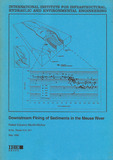Mostrar el registro sencillo del ítem
Downstream Fining of Sediments in the Meuse River
| dc.contributor.advisor | Klaassen, Gerrit J. | |
| dc.creator | Murillo Muñoz, Rafael Eduardo | |
| dc.date.accessioned | 2022-03-08T14:53:43Z | |
| dc.date.available | 2022-03-08T14:53:43Z | |
| dc.date.issued | 1998 | |
| dc.identifier.uri | https://hdl.handle.net/10669/85969 | |
| dc.description.abstract | The Meuse River (Maas River), the second largest river in The Netherlands, enters the country as a gravel-bed river. Near the city of Roermond, in the so-called Roer Graben, an area where tectonics is known to be active, the river shows a sharp transition from a gravel-bed river with pronounced armouring to a sand-bed river with bedforms. During this transition the D50 of the bed material changes from about 16 to about 2.6 millimetres whilst the bed slope also decreases from about 0.48 to 0.10 m/km. Until now the cause of this transition is not known. The present study attempts to explain this gravel-sand transition by studying the different phenomena that can play a role. The following possible causes can be listed: i) abrasion and breakdown of the bed material particles; ii) vertical tectonic movements (uplift and subsidence) which will induce longitudinal sorting of the bed material within the Roer Graben Rift system; iii) the presence of ancient deposits; and iv) the input of fine sediments from a smaller tributary. The latter two were considered to be of minor importance. To study the different phenomena it was necessary to link the prototype information on the present river characteristics to the limited available geological information of the area. In the first phase of the study a substantial effort was put in the elaboration of field data, whereby information on both changes in bed material (particle distribution and mineralogy) along the river and the sediment transport rates were collected, analysed and critically assessed. Also the available information on the geology of the region and on tectonic activity like subsidence was reviewed in this phase. In a next phase the relevance of the different possible explanations was assessed. Abrasion rates for the different minerals were determined and an estimate of their importance was made. Also the effect of the subsidence and the induced deposition on sediment transport rates, longitudinal sorting and on the particle distribution was assessed. Moreover a numerical (1D morphological) model developed by Cui and Parker (1998) was used to verify the conclusions of the first assessment more quantitatively. Although the model is not completely applicable to the Meuse River, it provided additional support for the conclusions of the study. From the study of the available field data and the tectonics of the region, the initial assessment and the numerical simulation of the different process involved, it is concluded that the subsidence in the Roer Graben provides an adequate environment of deposition triggering the selective transport of particles causing the coarse material to settle preferentially. The combined action of the selective transport and the abrasion of sandstone results in an increase of the sand content of the bed material in downstream direction. After some distance a threshold point is reached where the sand content starts to govern the behaviour of the sediment mixture. In combination this causes that the sand “overwhelms” the gravel and the river starts to behave as a sand-bed river; consequently the gravel-sand transition is formed. The improved understanding of the morphological behaviour of the Meuse River and the possible explanation of the sharp transition, allowed to formulate some implications for future field data collection and for numerical modelling of the morphology of the complicated reach of the Meuse River where the transition takes place. It is clear however that the extensive human interference with the river in the 19th and 20th century (normalisation, reservoirs, barrages, and gravel mining) in combination with the complicated geological conditions in the area will never allow for a full understanding of the morphological behaviour of the river. | es_ES |
| dc.description.sponsorship | Ministry of Transport, Public Works and Water Management/[]//Países Bajos | es_ES |
| dc.description.sponsorship | Institute for Inland Water Management and Waste Water Treatment/[]/RIZA/Unión Europea | es_ES |
| dc.description.sponsorship | International Institute for Infrastructural, Hydraulic and Environmental Engineering/[]/IHE/Países Bajos | es_ES |
| dc.language.iso | eng | es_ES |
| dc.relation.ispartofseries | IHE M.Sc. thesis HH;341 | |
| dc.source | Delft, Países Bajos: International Institute for Infrastructural Hydraulic and Environmental Engineering (IHE-Delft) | es_ES |
| dc.subject | Sedimentation | es_ES |
| dc.subject | Downstream fining | es_ES |
| dc.subject | Meuse river | es_ES |
| dc.subject | hydraulic engineering | es_ES |
| dc.subject | Sediments | es_ES |
| dc.subject | Water engineering | es_ES |
| dc.subject | Selective transport | es_ES |
| dc.subject | Abrasion | es_ES |
| dc.subject | Subsidence | es_ES |
| dc.subject | Neotectonics | es_ES |
| dc.title | Downstream Fining of Sediments in the Meuse River | es_ES |
| dc.type | tesis de maestría | |
| dc.description.procedence | UCR::Vicerrectoría de Docencia::Ingeniería::Facultad de Ingeniería::Escuela de Ingeniería Civil | es_ES |
Ficheros en el ítem
Este ítem aparece en la(s) siguiente(s) colección(ones)
-
Ingeniería civil [701]


